Let the restless soul in you find the spiritual serenity and wonderment of the creativity of man in the superb temples of Haledbedu and Belur in Hassan District in the southern state of Karnataka. Dating back to the days of Hoysala rule, which extended from 1006 to about 1346 in the Deccan, this fabulous ensemble of temples reflects the pluralistic approach of the rulers to religion and temple architecture which embraces both Dravidian-style design with Bhumija and Nagara traditions. For those not in the know, the Nagara style of temple architecture, popular in northern India, involves the entire temple being built on a stone platform with steps leading up to it. Usually there are no elaborate boundary walls or gateways, and the garbhagriha or sanctum lies directly under the tallest tower. Bhumija is another version of the Nagara temple. These have a flat upward tapering projection comprising a central Latina spire and miniature spires on the quadrant formed by the tapering tower. These mini shikaras are carved out both horizontally and vertically. Dravidian Style involves the temple being enclosed within a compound wall. The gopuram is the entrance in the centre of the front wall. The vimana is the shape of the main temple tower, a stepped pyramid that rises geometrically. Guarding the entrance of the sanctum are sculptures of fierce dvarapalas.
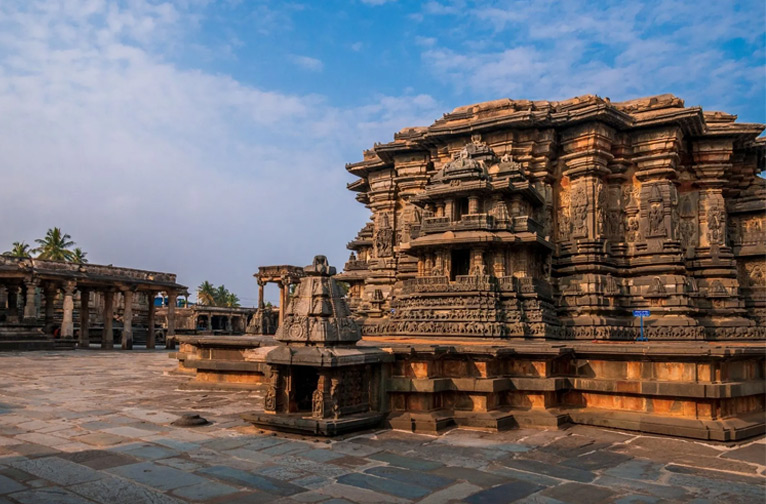
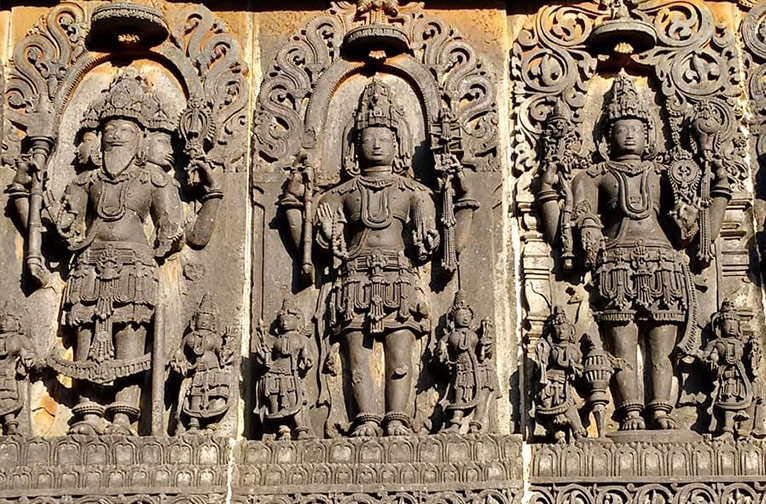
The Hoysalas built over 1500 temples scattered across their empire, of which only a little over 100 survive today. Their most remarkable architectural achievement is the numerous intricately carved stone temples in star-shaped plans. The architecture of the Hoysalas is a hybrid of the Nagara style of temple architecture of north India and the Dravidian style from the South. At a time when temples were rectangular based on ancient treatises, the Hoysala temples were temples were unique in their star-shaped plans, complex forms, and raised platforms. Their formal geometry and the unparalleled artistry of their sculptural details have earned them recognition as outstanding masterpieces of South Asian art. The temples, cut from the soft stone called chloritic schist, were not just sacred spaces for worship; they were extraordinary expressions of spiritual purpose and vehicles of spiritual practice and attainment.
Halebedu is famed for that remarkable architectural marvel, the Hoysaleshwara Temple dedicated to Shiva. It has over 240 wall sculptures running across the outer wall. Intricately carved friezes express aspirational spiritual qualities, symbolism, and mythology. This is a dikutachala temple–two shrines on the same platform. Both shrines are devoted to Shiva. Sculpturally and artistically, the Hoysaleshwara Temple trumps all the other extant Hoysala temples.
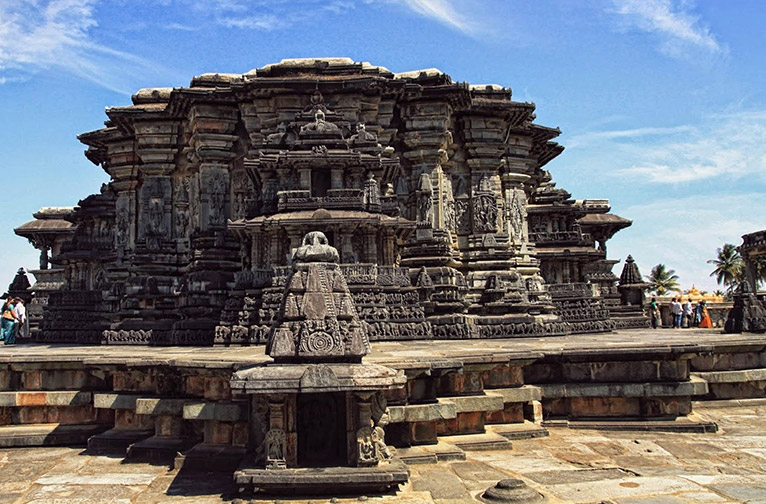
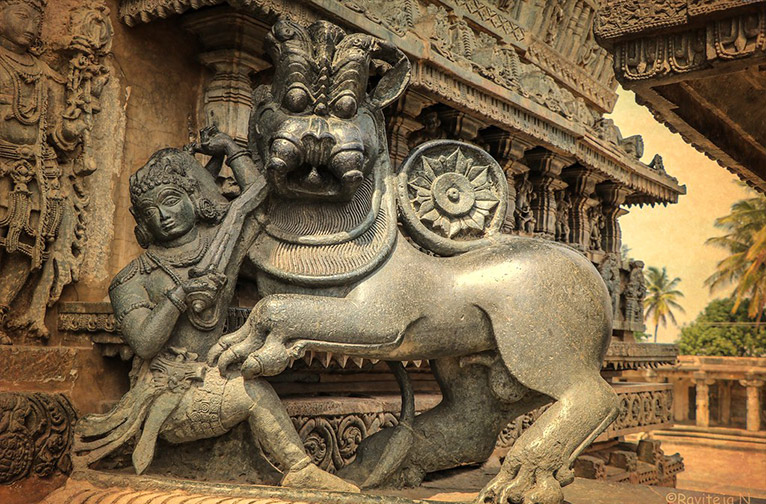
Feast your eyes on the works of skilled hand from ancient times in those meticulously crafted religious and cultural iconography depicting gods and goddesses, wars and victories, dance and music, hunting, games, processions, and the dress, jewelry, and daily life of people–as well as episodes from the Mahabharata and Ramayana and Bhagavata Purana in the exquisite friezes on temple walls. What’s interesting to note about that extensive iconographic representation from the epics is ‘that in temple architecture these do not merely serve a decorative purpose, but are essential to the integrity and composition of the structure. These reliefs are deeply valued for their preserving of one of the finest achievements of Hoysala artisans and make up an exhaustive lesson in the symbology of Hindu art. The Kedareshwara temple complex raised to Lord Shiva comprises three shrines. Though the workmanship is not as exquisite as that at the Hoysaleshwara Temple, it remains true to the genre’s lead features. Keep your eyes peeled for the sculptural details, illustrating the splendidly executed Bhairava, Vishnu as Bharadwaj and Kaliyadamana.
Having steeped yourself in this incredible plenitude don’t be surprised if it encourages you to shift gears and turn towards to cluster of Jain basadis or Jain temples.
Hinduism and Jainism both flourished apace under the patronage of the Hoysala. Basadihalli village nearby features three Jain shrines devoted to the Jain Tirthankaras - Adinatha Swamy, Parshwanatha Swamy and Swaminatha Swamy. While the sculpture of Parshwanatha Swamy, with a seven-headed snake carved on his head, is certainly noteworthy, what blows you away is the rich ornamentation of the intricately carved pillars, a genuine reflection of Hoysala crafting traditions in religious architecture. Abandon yourself to this profusion of creativity and meditative silence that pervades the spot.
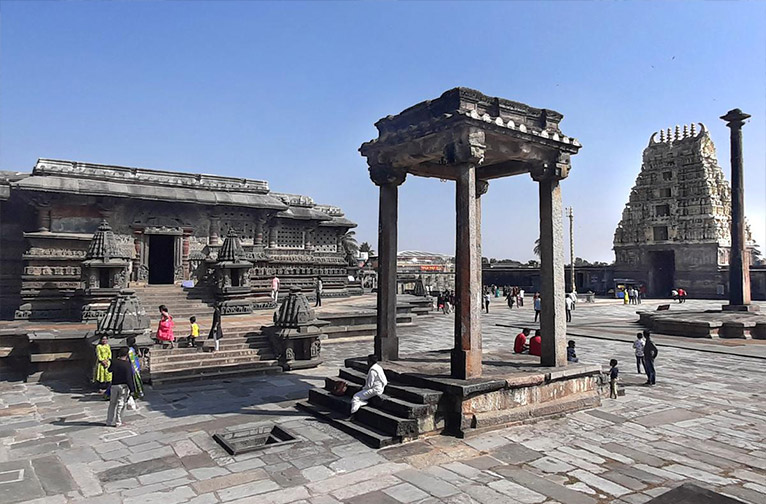
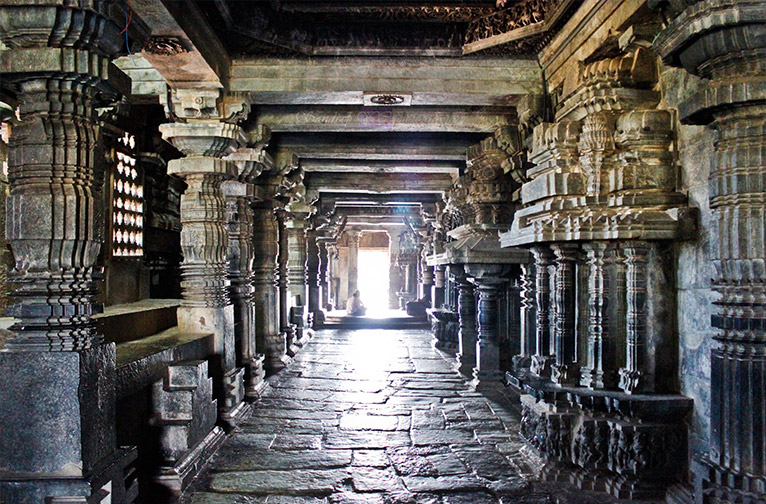
Belur is a compelling bastion of Hoysala architectural pursuits. Not all the Hoysala temples were completed within the reign of the king who commissioned them. Belur’s extraordinary Chennakesava Temple, devoted to Vishnu, took 103 years to be completed, leaving a lot to the imagination of the visitors about what all would have transpired over that long journey. Yet what remains a constant despite the march of time is that it is a thrill-giving representation of the astonishing works of stone art and architecture of Hoysala-style temple building. An ekatachala temple–a single shrine on a single platform, the Chennakesava temple features an intricately ornamented image of Chennakesava flanked on either side by consorts Bhudevi and Sridevi.
The marvel is that many shrines of Halebedu and Belur, these twin jewels of Hoysala architectural vison, are living temples to this day, having been continuously in use since they were established. Drench yourself in the rich atmospherics of these repositories of piety and creative inspiration. A onetime visit will not suffice; plan on returning many times to Halebedu and Belur to get the full measure of this fabulous canvas of creative endeavour.